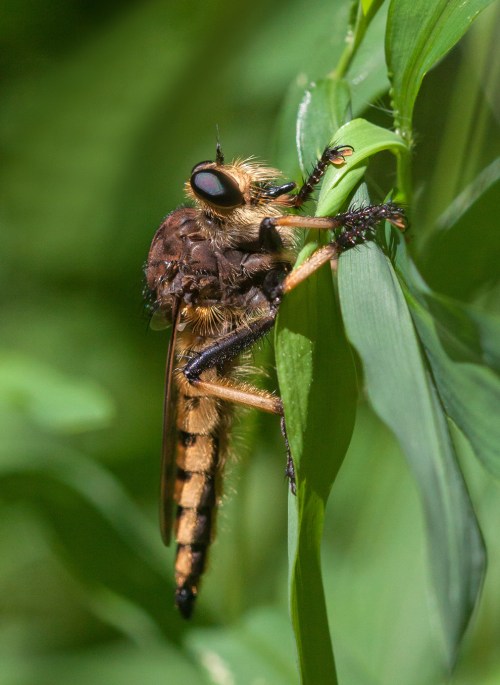Most dragonflies are slender and acrobatic, prompting one of my friends recently to call them “dainty.” There is absolutely nothing dainty, however, about Dragonhunter dragonflies (Hagenius brevistylus)—with their massive upper bodies and powerful legs, they remind me of powerlifters. Dragonhunters, unlike some other large dragonflies, do not fly patrols overhead in their search for food. Instead, they are patient hunters who perch, waiting for passing prey, and then use their powerful back legs to snag their victims, which are often other dragonflies.
One thing that always strikes me when I spot perched Dragonhunters is that they seem uncomfortable. Their back legs are so long and ungainly that Dragonhunters’ poses look awkward, bringing to mind gawky teenage males who have undergone recent growth spurts and have not yet gotten used to their longer limbs.
I was thrilled to spot this Dragonhunter last week while exploring a stream in Fairfax County with my friend and fellow dragonfly enthusiast Walter Sanford. It was a hot, humid day and we did not have any success in finding Eastern Least Clubtails, our main focus for the day. In fact, during the day we did not see many dragonflies at all. Walter had been at this location repeatedly and at the start of the day had commented to me that he had often seen Dragonhunters perched on branches overhanging the stream. In fact, we spotted Dragonhunters several times during the day, but did not manage to get good shots of them.
As the skies began to darken, signaling an approaching rainstorm, I knew our time was drawing to an end. I decided to return to a fallen tree where we had seen a Dragonhunter earlier in the day and was pleasantly surprised to see a Dragonhunter holding on to the very tip of a branch. I waded into the stream and moved a little closer to the dragonfly, slowly making my way across the slick, uneven rocks. I called out loudly to Walter, who was a good distance downstream from me, and eventually I heard his response.
I became the patient hunter now as I stood in the calf-high waters of the stream, trying to minimize my movements as I struggled to get a decent shot without disturbing the dragonfly, waiting for the arrival of my friend and hoping that the dragonfly would stay in place. Well, Walter arrived and we both managed to get some shots. I then felt free to move a bit more and crouched low to get a better angle for a shot. Lost in the moment, I did not initially notice that my backside was getting wetter and wetter as I squatted lower and lower. Fortunately I had moved my wallet and keys to my backpack which remained dry.
Eventually the Dragonhunter flew away from its initial perch, but the flights were short and relatively direct and we were able to track the dragonfly to its subsequent positions. The Dragonhunter looked a bit more comfortable at its new perches, but I was not. The rocks underfoot were getting bigger and more uneven and navigation through the water was increasingly difficult. At one moment I encountered an unexpected small drop (maybe 6 inches or so) and I slipped and momentarily lost my balance, but somehow managed to stay dry.
I was tired and wet when we began the uphill trudge back to the parking area, but I was feeling happy about our encounter with this Dragonhunter, one of the powerful giants of the dragonfly world. If you would like to see Walter’s photos and commentary on our Dragonhunter adventure, be sure to check out his blog posting today entitled “Dragonhunter dragonfly (male).” While you are there, be sure to poke around on his site—he has lots of cool images and fascinating information on all kinds of dragonflies and other creatures too.
© Michael Q. Powell. All rights reserved.












